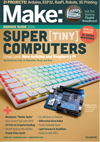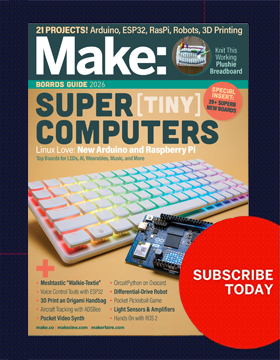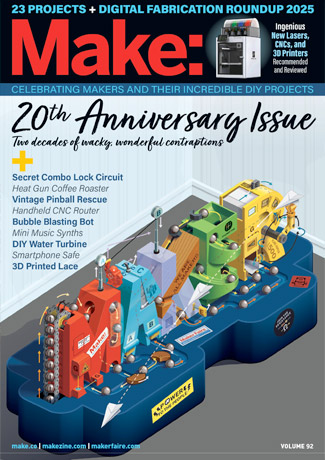
This is a transcript of the talk MakerBot CEO Bre Pettis gave at Thursday’s Open Hardware Summit in New York. It is based on the official recorded video stream of Session 3, which is available in its entirety here. Bre’s talk begins at about 1:20:41.
Woo, it’s been a week.
(laughter)
I’m Bre, Makerbot, and last week we raised a little bit of a ruckus launching this machine.
Our goal at MakerBot from the beginning was to make a 3D printer for everyone, and make it as accessible as possible, so that every creative explorer could have a tool to make anything they needed.
I think everyone who has been in involved in open hardware, or has been an employee of MakerBot, or contribute to MakerBot can see this machine as a win, for open hardware. We started, and well our first mission, was to put 3D printers on the desktops of everyone. We did this with an open, like literally, an open heart, to try and make this work. And it came from our desire to share.
So, to be kind of clear, I will say this machine is not 100% open, but we just released—well actually we’ve been developing it in the wild—the software. We’ve got the Makerbot Slicing Engine, possibly the best slicing engine ever made. It does in seconds what used to take hours, and that’s all open.
We’ve got the MakerBot Firmware, and MakerBot driver—open. The software alone represents over a million dollars in people working, being paid, during the day, to do this work.
On the hardware side, we’ve kept the MightyBoard for the Replicator 2, same thing as the Replicator 1. And we made a little tweak, but functionally the exact same board, and the extruder is functionally the exact same extruder. People are like, “Why are you publishing these?” and, it’s like, “Well, they’re the same. We did.”
So, we’re really proud to put these things out in the world. When we started we started with the prototype. These machines, you can really see, that we started pretty rough, we literally made a prototype and were like, “Great, it works, let’s ship it.”
And you can see we’ve got a kind of progression here, as we’ve been progressing towards getting to a machine that’s more universally friendly, that’s more accessible to a wider group of people. And our first, like 50% of the people who bought them originally were programmers, which I think says something to the character of the machine, and the maker ethic behind it, and when we shifted to the Replicator 1, the original Replicator, people were like, “What? I don’t get to put it together anymore?”
And we’re like, “Yeah, there’s a lot of reasons for that.” We make it assembled, because otherwise it takes about 8 to 9 hours of customer support to help people make it. But, people were pretty upset that we didn’t have it as a kit, anymore. And that was a bummer for us because, we’re like, “But it’s so easy for you to make other things with it, and you don’t get bogged down.” And sales kinda went through the roof, so that was one of those things where we saw, first of all, the core of our community shift a little bit, and open out to a bigger community.
There’s been a lot of derivatives of these. We really like, like for example, there’s a guy named W.J. Steele who just lauched UltraBot. He’s got a campaign on kickstarter. He made a derivative of a Cupcake. And he did this by really liking his Cupcake and making modifications upon modifications until he basically had a new machine. And then he launched a whole kickstarter on it, and we think that’s cool.
Stuff like this. So, this is a MakerBot on AliBaba for about half the cost that you can get for the original Replicator. And I got a lot of flak, people said, you did open source hardware, this is totally allowed underneath the licenses that you released things under, you know, what did you expect? And it’s true, they’re right, this is a result of something that we did, but it doesn’t mean we have to like it.
Some of the shifts we’ve just made, that’ve made some people grumpy. We are not sharing the design files for the body of the Replicator 2. That’s because it’s powder coated steel, and unless you have, like, an open-source steelbender, you’re not going to be able to do this, it’s not something you can do, at home. It’s something that really you have to have a manufacturing facility to do.
We’re also not sharing the GUI of MakerBot MakerWare, which is the software that runs it. That’s just because we want to have a chance to control the look and the feel and the experience of the user. And these things are really valuable to people who wanna clone us and just make, like, carbon-copy clones, and we’re not…and we’re not into that. But, it’s still hackable, still modifiable.
You know, we got a lot of criticism for this, and I, personally, you know, I’ve been on the Internet for a long time, so I’m used to bad language and disrespectful behavior, but I think that one of the downsides, and one of the challenges that we face as a community, is when the trolls come out, and they get some traction, and, like, we really had a rough week, where people were, like, we’re not 100% open source, die!
Um, other companies, and other individuals, and other people seeing projects saw a lot of ugliness from the community, last week, and that doesn’t encourage people to be more open. And I think that’s something to talk about, is how do we encourage people to grow the projects into business, and how to grow their business into successful large businesses, that can hire a lot people, and let people shift from doing open source from something they do on nights and weekends, into something that do for their day job.
(applause)
Thank you.
So,I wanted to address that, and kind of wrap that up, and hopefully show you a little bit about this. I’ve written about this extensively, spent my weekend responding to comments, on the MakerBot blog, so if you want to get more into that, there’s more information there.
Um, I’m gonna talk about stuff that I’m excited about, now. I see that the wages of workers in places like China are going up. In the past three years many factories have had wages triple. This gives an opportunity to, for one thing, other places to manufacture things, and furthermore, not just manufacturers to manufacture things. With the tools that we have today, we have the opportunity to take manufacturing back into the home, back into the garages. You used to have to think about making a product, and you had to think 10,000 to 100,000 units, to justify manufacturing it, to get it past the idea stage of it. Now we’re in a place where, with 3D printing, and with the kind of tools we’re kind of all collectively making, we have an opportunity to empower so much awesome creativity and innovation in the world. Things are shifting. And you can smell it. You can smell it in this room really strongly.
It’s a good smell.
The cool thing about this is, more and more of us…I’m kind of curious—I can’t really see you very well—but can anybody who, in their day job, they create open source infrastructure, can you raise your hands? Can we give all these people a round of applause.
(applause)
What do we have to do so that all of you can raise your hands for that question, so that you can all be contributing to the greater good?
The big what happens next is really going to really be powered, and people are going to be inspired, what happens next is going to happen because the people in this room and how they inspire others, and what they do to make that happen.
I have to say, for all the drama, a lot of people have stepped up in the last week, and given us feedback, and criticism, constructive criticism, and support. I’ve had a number of people here come up to me and say, I own a business, I know exactly where you’re at, it sucks, I support you. Even the people who gave us constructive criticism, I want to say from everyone at MakerBot—this is a photo taken in our manufacturing facility—thank you for supporting us.
I think that’s it. So, thank you very much.
(applause)
ADVERTISEMENT














